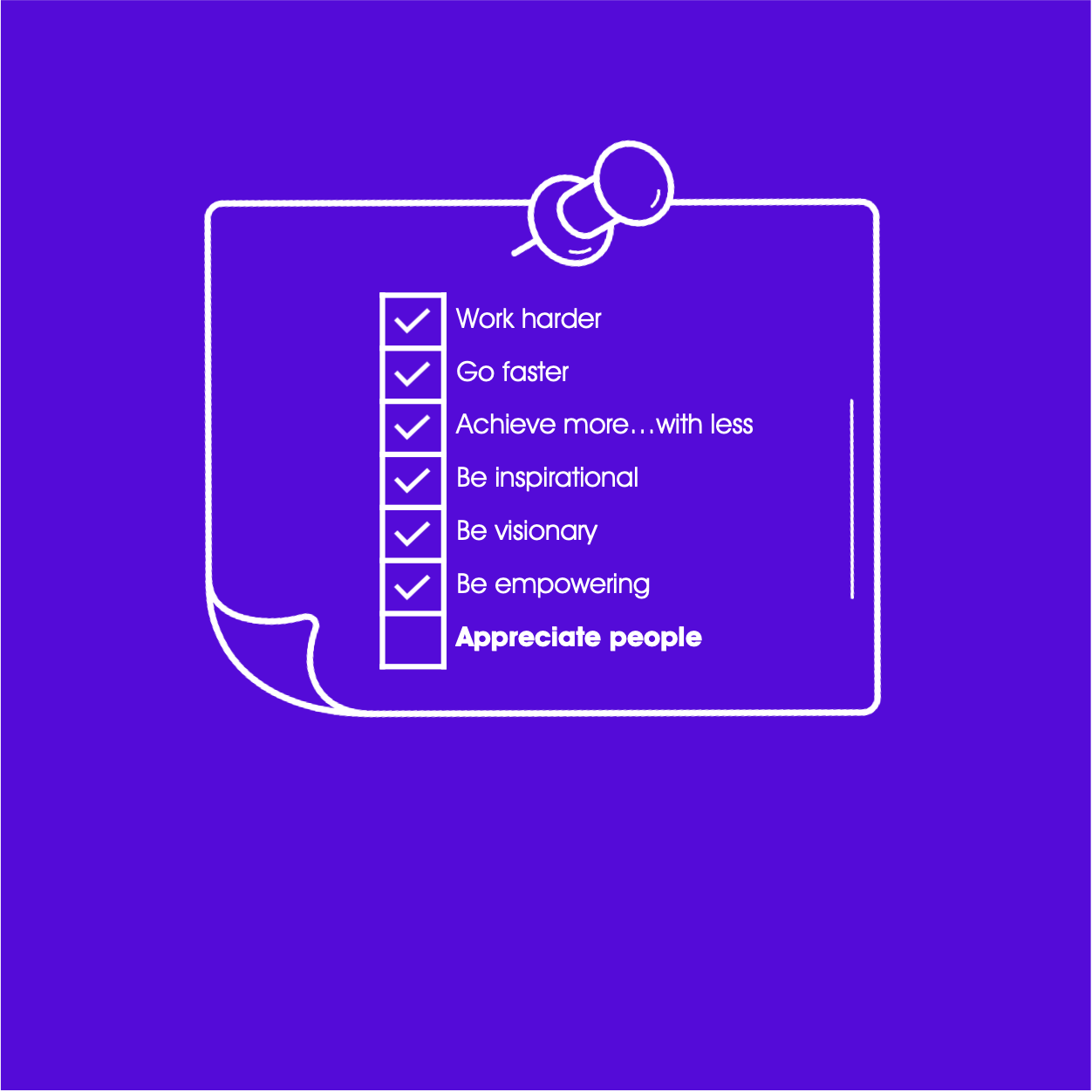Artificial Acknowledgement
Leadership Blog | 6 minute read

Written by Justin Temblett-Wood

It’s easy to assume that a sense of empowerment comes from within an individual, and that courage and initiative is their own responsibility.
There may be some truth in that, but for most people to feel empowered at work, leaders need to create a culture that not only allows empowerment, but actively nourishes it, encourages it, and creates opportunities for it to be seized.
This is the case for leaders of all levels. That said, if the CEO and senior management don’t role-model empowerment at the top level, it won’t flow throughout the rest of the organisation.
Think of a champagne fountain - whatever you pour into the top glass, is what will trickle down into all the glasses below. It’s the same in any business. If a culture of empowerment is strong at the top, it will feed down into everybody in the organisation.
Empowerment through acknowledgment
Who leaders acknowledge, why they acknowledge, and the way they acknowledge is culture shaping. It creates an invisible context for how empowered people are going to feel and how much permission they will take themselves.
A good way to facilitate this shift is making the move away from a culture of COP (control, order, predict) towards a culture of ACE (acknowledge, create, empower) in order to be as agile and convention-challenging as possible. But this isn’t a simple transition.
While organisational structures, pay structures, and reporting lines are essential in creating this shift – they are not the whole picture when it comes to acknowledgement that empowers people.
Artificial empowerment can arise when leaders understand the ACE style of leadership but can’t execute it effectively. This results in well-meaning but nevertheless artificial acknowledgement. This can make it feel like an awkward box-ticking exercise and people will easily truffle it out.
This can occur when a leader uses repetitive or formulaic tactics to acknowledge; using the same criteria each time to decide who’s owing of praise, and the same approach to giving it. This can mean the people who get acknowledged and thus empowered, are also predictable and repetitive. In turn this can empower a culture of trying to emulate one way of doing things; because we know the boss is only looking for one type of work ethic, behaviours or personality trait. What we really want acknowledgement to do is to champion individual commitment and achievement in any form or format that it might take, including going against the grain. This type of acknowledgment requires leaders to be really present to their people, to what makes them tick, and what an achievement looks like in the context of their organisation; both measurable and otherwise.
Why we should acknowledge
Our acknowledgements should be driving the team towards a collective, bigger commitment. If a leader’s acknowledgements are instead working towards hidden agendas or personal bias, they will fall short of being sincere.
For example, if a leader has a strong social dynamic with a member of the team, this doesn’t warrant showering them in acknowledgement for the purposes of strengthening that bond.
Similarly, a leader may have a background commitment to their own ego and is acknowledging someone to fall in favour with a certain group or individual in the organisation. Or perhaps they think they will even get some acknowledgment in return.
Another example is acknowledgment as currency for more work. Praising only the people or instances where over-work has happened, as a means of embedding an overtime culture.
These are easy traps to fall into. Just because someone’s acknowledgement has another, often unconscious agenda, it doesn’t mean they’re being purposefully manipulative.
It could be that they want to give praise but haven’t made the time to give it much thought, or they’re praising the things they personally value the most as that’s what shows up.
If we’re to make a meaningful and consistent impact with acknowledgement, one that drives an empowerment and confidence in others, we need to understand the nuances of how to deliver it.
Acknowledgement needs to be aligned to driving the commitment to the breakthrough that you’re collectively going for. Sometimes that might mean acknowledging people or behaviours that aren’t typical of your organisation, but if you look closely, are making a real difference.
What you acknowledge
A leader alone can’t decide the values of an organisation. They can write words like “integrity” and “respect” on the wall until they run out of ink, but it is really the culture of the organisation that dictates the authentic values of the business.
As such, a leader needs to make sure the “what” and the “who” they acknowledge aligns with and drives the values of the business.
All companies have star performers. Maybe it’s a salesperson who’s delivering brilliant results week after week or a compliance officer who fiercely protects the business’ interests. No doubt they will receive recognition for this achievement, and rightly so, but it’s vital that they also uphold the authentic values of the business.
If they don’t uphold these values but are acknowledged as role-models regardless, it can undermine the culture and values of the organisation. This leads to disillusionment and can be disempowering – making the team feel that only some behaviours and values are acknowledged whilst others are meaningless.
Who a leader acknowledges sets a benchmark for how people think they need to behave in order to succeed. You need to be conscious about the sort of individuals you are holding up and showing recognition to. This will lay the foundation for everyone to work towards the same collective vision and achieve breakthrough.
How you acknowledge
Our context is decisive, and the acknowledgment of your team needs to be based on how they want to be acknowledged, not how you want to acknowledge them.
It needs to be tailor-made to each individual otherwise they may not feel as though they’ve even been acknowledged. It will look like different things to different people, and it needs to be delivered in a way that is relevant to them.
For example, if someone has vocalised that what matters to them most is payment progression or progressing within the organisation, giving them a round of applause in a team meeting isn’t going to count for much.
Likewise, if someone is happy with their pay but feels like they don’t get the recognition from the company that they deserve, a monetary reward isn’t going to motivate or empower.
Acknowledgement isn’t a one-size-fits-all affair, and leaders need to be aware of what will speak into the listening of individuals.
Gary Chapman and Paul White have modelled the 5 Languages of Appreciation, 4 of which are very translatable into the workplace:
- 1. Words of Affirmation
- 2. Quality Time
- 3. Acts of Service
- 4. Tangible Gifts.
These are great anchors to start from: asking which of these 4 ways of acknowledging feels most like true appreciation to your team members. Knowing how you give back to your people ensures they feel the acknowledgement you’re trying to give, and benefit from the empowerment that acknowledgement feeds.
This in turn can start a wider conversation about the commitments and values we’re working towards and the types of behaviours we want to adopt and consequently acknowledge.
Looking to create an impossible future? Get in touch to explore how we can help you ignite your ambitions.
Published 12/08/2021
Subscribe by Email
Achieve more breakthroughs. Get expert leadership ideas, insights and advice straight to your inbox every Saturday, as well as the occasional bit of news on us, such as offers and invitations to participate in things like events, webinars and surveys. Read. Lead. Breakthrough.
Tags
- Attracting talent
- Behaviour change
- Blended Learning
- Breakthrough Thinking
- Business partnering
- Career planning
- Change management
- Collaboration
- Communication
- Competitive strategy
- Creativity
- Decision making
- Developing middle management
- Developing millennials
- Developing talent
- Employee engagement
- Entrepreneurship
- High performing teams
- Hiring
- Human Resource Management
- Innovation
- Leadership development
- Learning technology
- Managing people
- Managing uncertainty
- Managing yourself
- Mergers & Acquisitions
- Mindset
- Motivating people
- Negotiation
- Organisational culture
- Organisational development
- Organisational values & purpose
- Performance management
- Productivity
- Programme Management
- Retaining talent
- Strategic thinking
- Strategy
- Strategy execution
- Succession planning
- Team development
- Work-life balance
Related posts
Leadership Blog
Leadership burnout: Expanding bandwidth to thrive through complexity
Achieve Breakthrough | 16/12/2025
Leadership Blog
What triggers you as a leader, and how to work with it?
Achieve Breakthrough | 09/12/2025
Leadership Blog
Why it’s impossible to lead with one foot still in your old role
Achieve Breakthrough | 03/12/2025
Leadership Blog
Why a leader’s true value lies in what they enable, not just what they know
Achieve Breakthrough | 25/11/2025
